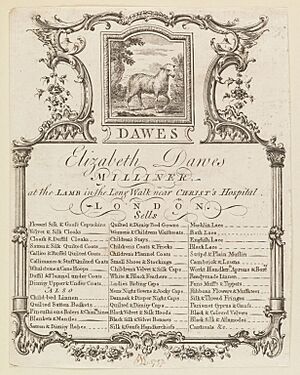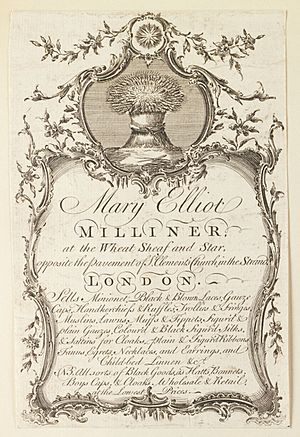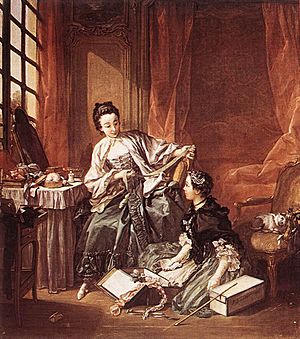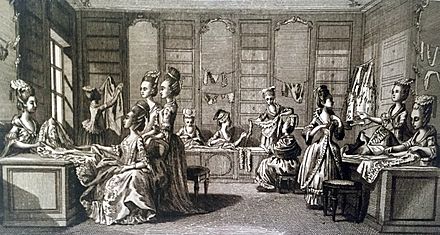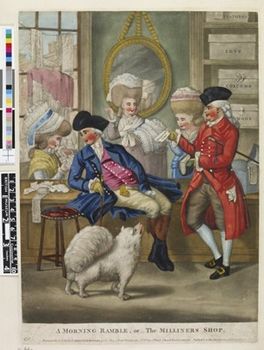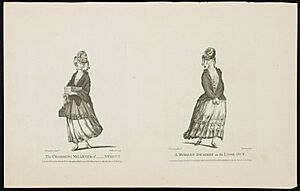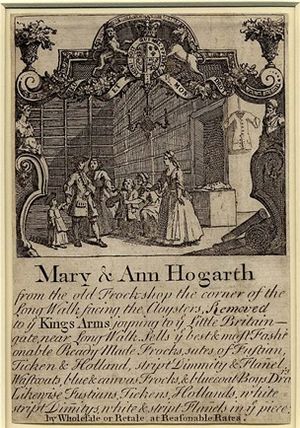Eleanor Mosley facts for kids
Eleanor Mosley (also known as Elinor Mosely; born around 1700) was a clever English milliner who ran her own successful business. She was also a member of the important Worshipful Company of Clockmakers in London. Eleanor managed her business as a single woman in the 1700s, which was quite a big achievement back then!
Contents
Eleanor Mosley's Life and Business
Eleanor Mosley grew up in York, England. Her father was a successful apothecary, which was like a pharmacist who also prepared medicines. When she was 17, in April 1718, Eleanor started an apprenticeship with George and Lucy Tyler. An apprenticeship was a way to learn a trade by working for an experienced master or mistress for several years.
The Tylers were part of the Worshipful Company of Clockmakers, a special group for clockmakers. George Tyler was a registered master in this company. The Tylers trained six young women as apprentices between 1714 and 1725. Since George was a clockmaker, it's likely these young women learned their skills from his wife, Lucy.
Becoming a Business Owner
In 1727, Eleanor finished her apprenticeship. She then became a full member, or "mistress," of the Clockmakers' Company herself. This allowed her to open her own business in London. That same year, she took on her own sister, Catherine, as an apprentice. A month later, she took on a second apprentice named Mary Bate. Mary was the daughter of a clergyman from Kent. Eleanor was paid £50 for each girl, which was a lot of money at the time!
Eleanor had other sisters who also became milliners. Elizabeth trained in York, and Dorothy eventually took over Eleanor's business.
Growing Her Business
In 1729, Eleanor moved her shop to a rented spot on Lombard Street. By 1736, she was successful enough to buy her own property on nearby Gracechurch Street. She lived and worked there with her apprentices for at least ten years. This part of London was a busy market area, full of wealthy merchants like goldsmiths, bankers, and other shop owners.
Eleanor continued to take on apprentices. In 1732, Mary Newton, the daughter of a London goldsmith, joined her. Eleanor's first two apprentices finished their training in 1734. She then took on her fourth apprentice that same year. She had two more apprentices in 1738 and her seventh and final registered apprentice in 1739.
Eleanor was the only owner of her business. Her name was the only one on the tax records. Besides her apprentices, she likely had household servants and other shop helpers.
Eleanor's Later Life
The Clockmakers' Company recorded Eleanor's marriage in 1747, when she was in her for forties. Marrying later in life wasn't unheard of back then. Even though her property on Gracechurch Street stayed in her maiden name, she moved out after 1744. We don't know her husband's name or if she kept working in another location. Many women in 18th-century London continued to work after marriage.
In 1749, Eleanor's sister Dorothy started renting the shop from her. The last official mention of Eleanor Mosley was in 1752, when Dorothy took full possession of the property. It's not clear if Dorothy bought the property or if she inherited it after Eleanor's death.
Eleanor Mosley was a remarkable woman for her time. Many unmarried women worked as domestic servants. But Eleanor was a skilled craftswoman and a businesswoman. She successfully ran her own shop for at least 15 years in a wealthy part of London. She was also a member of a trade company in her own right. Most women joined these companies through their husbands. Eleanor received high payments for her apprentices and always had at least two working for her. After marrying, she passed her business to her sister.
London Trade Companies and Apprenticeships
In the 1700s, many London trade groups, called Livery Companies, no longer controlled specific trades. Members could practice a trade different from the company's name. To run a business in the City of London, both men (masters) and women (mistresses) had to be members of one of these companies.
Milliners and Trade Companies
Milliners didn't have their own special trade company. So, they had to join other companies. Eleanor Mosley and only one other woman were listed as milliners in the Clockmakers' records. However, it's very likely more women were milliners.
Some companies did specify trades for their members, and more milliners are found there. Women made up only a small part of these companies (1-2%). But a lot of these women were milliners. For example, almost half the girls apprenticed in the Haberdashers' Company in the early 1700s trained with milliners. In the Grocers' Company, two-thirds of girls apprenticed between 1717 and 1743 were with milliners.
You could join a trade company in a few ways:
- By finishing an apprenticeship (like Eleanor did).
- Through your father.
- By buying a membership.
- By marriage (most women joined this way).
The Cost of Learning a Trade
Parents paid a "premium" to the master or mistress for an apprenticeship. Apprenticeships usually started when children were teenagers and lasted seven years. The payments for a millinery apprenticeship were quite high. They were about the same as what it cost to train a boy to be a merchant or an apothecary.
What Was a Milliner?
Today, a milliner usually means someone who makes hats. But in the 1700s, it was much more!
The Oxford English Dictionary says an 18th-century milliner was a "seller of fancy wares, accessories, and apparel." These items might have originally come from Milan, Italy, or the name might have come from selling "a thousand things."
Another idea is that "milliner" came from "Millaner." These were merchants from Milan who traveled to northern Europe. They brought all sorts of goods like silk, ribbons, lace, and other beautiful items. They also shared news of the latest fashions for both men and women. The term started in the early 1500s. Milliners also sold fine straw hats from Florence, which might be why some focused on hat-making later on.
We don't have any trade cards from Eleanor Mosley. But these cards from around 1757-1758 show the many different things a milliner might sell.
In 1747, a guide called The London Tradesman listed what a milliner did: "The Milliner makes and provides ladies with all sorts of linen for clothing, from undergarments to neck scarves. They supply Holland cloth, cambric, lawn, and lace of all kinds. They turn these into undergarments, aprons, scarves, handkerchiefs, neckties, ruffles, caps. They make cloaks, mantles, and capes of silk or velvet, plain or decorated, and trim them with silver, gold, or black lace. They make and sell hats, hoods, and caps of all types. They also provide gloves, muffs, and ribbons. They sell petticoats and hoops of all sizes."
The Rise of Female Milliners
In the 1600s, most milliners were men. But women's fashion changed, and more women became milliners. The "mantua" became popular. This was an open-front gown with a loose top, cut in one piece with the skirt. It was worn over a corset and petticoat. The skirt was draped up to show the petticoat underneath. The mantua started as a casual gown but became formal enough for court.
The front of the mantua's top was filled with a stomacher. These were often covered with lace, ribbons, and other decorations. Before this, most women's clothes were made by tailors. But the mantua was easier to make, so seamstresses started making them. Before, seamstresses mostly made simple things like shirts and collars. Even as the mantua style changed, women continued to make all kinds of women's clothing. The term "mantuamaker" became another word for a dressmaker.
Female milliners grew from the mantuamakers. They were at the top, hiring mantuamakers, seamstresses, and other specialists. Milliners often offered many services. A study of women in business from 1760 to 1830 showed milliners combined their trade with over a dozen others, like embroiderer, draper, dressmaker, and even funeral furnisher!
The style of dresses didn't change much in the 1700s. This made the trimmings and accessories even more important, and many came from the milliner. Clothing was the second biggest expense after food, so clothes were often remade or restyled. From dress styles to trimmings, accessories, and caps, the milliner was a key source of materials and fashion advice.
Image and Reputation
Milliners had to be their own best advertisement. So, they, their apprentices, and shop girls dressed in the latest styles. Even with their own shop, milliners often visited clients' homes to show goods or deliver items. The painting by François Boucher, The Milliner (The Morning), shows a well-dressed young woman with her tools: bandboxes, trims, and a measuring stick.
This print by Denis Diderot from his Encyclopédie shows a dressmaker's shop. It's full of well-dressed young women helping female customers choose dresses and accessories. Eleanor Mosley's shop was probably very similar.
Some other images, like Robert Dighton's A Mourning Ramble, show young women who seem more interested in flirting than selling. A satirical print by James Caldwell even compares a "Charming Millener" to a woman of questionable morals.
The London Tradesman actually warned young women against becoming milliners. It said that the many young men visiting milliners' shops exposed young women to temptations. It claimed that many young women working in these shops were "ruined."
A Respected Profession
However, other historians have studied the trade more closely. They believe milliners were actually highly respected. Research by Amy Erickson and Jessica Collins, using records from the Clockmakers' and Clothworkers' companies, shows that girls apprenticed to milliners came from middle-class families. Their fathers were clergymen, apothecaries, goldsmiths, clerks, and shopkeepers. In contrast, many boys apprenticed in the Clockmakers' company came from lower-status families. Jessica Collins also noted that most of the milliners working through the Clothworkers' Company were in important areas of London. This shows that the millinery trade was seen as prestigious.
While The London Tradesman warned against milliners, another guide called A General Description of All Trades (published the same year) called millinery "a considerable trade." In 1761, the Parents and Guardians Directory noted that "A milliner, in good business, will not take a girl with less than £40 or £50." This was a lot of money! It also said that setting up a millinery shop could cost £400 to £500, while a clockmaker's shop might only cost £100-£200. These were significant amounts of money back then.
Some critics thought milliners encouraged vanity in their customers. But others believed that female milliners helped women keep their modesty by allowing them to be dressed by other women, rather than by male tailors.
In the 1700s, millinery was seen as a respectable trade for middle-class women and even poorer upper-class women. These were women who wouldn't want to work as domestic servants or do manual labor. Amy Erickson suggests that parents apprenticed their daughters not because they couldn't marry, but to give them a good way to earn a living if the family didn't have money for a dowry. It also gave them skills that might attract a husband and support them throughout their lives.
Mary and Ann Hogarth, sisters of the artist William Hogarth, were contemporaries of Eleanor Mosley. They never married and supported themselves with their own millinery shop. Their brother even designed one of their business cards.
To be a successful milliner, you needed to be a skilled craftsperson, have a good sense of style, and be good at business. Eleanor Mosley's life shows how respected the trade was. She came from a respectable middle-class family, completed her apprenticeship, and became a member of a trade guild on her own. Her business was in a high-end area of London, and she ran it successfully for at least 15 years. Other well-to-do tradesmen paid high premiums to have their daughters train with her.
All the evidence suggests that millinery was a respected and acceptable trade. It was expected to provide a woman with a living, whether she was single or married, for her entire life.


